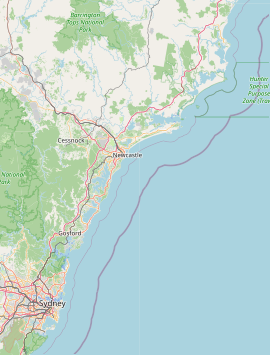Yarrawonga Park, New South Wales
Appearance
| Yarrawonga Park New South Wales | |||||||||||||||
|---|---|---|---|---|---|---|---|---|---|---|---|---|---|---|---|
| Coordinates | 33°05′53″S 151°32′06″E / 33.098°S 151.535°E | ||||||||||||||
| Population | 390 (2021 census)[1] | ||||||||||||||
| Postcode(s) | 2264 | ||||||||||||||
| Location | 7 km (4 mi) E of Morisset | ||||||||||||||
| LGA(s) | City of Lake Macquarie | ||||||||||||||
| Parish | Morisset | ||||||||||||||
| State electorate(s) | Lake Macquarie | ||||||||||||||
| Federal division(s) | Hunter | ||||||||||||||
| |||||||||||||||
Yarrawonga Park is a suburb of the City of Lake Macquarie in New South Wales, Australia, and is located on a peninsula east of the town of Morisset on the western side of Lake Macquarie.
History
[edit]The name is of Aboriginal origin but its meaning is uncertain.
The Awabakal people are the first people of this area.[2]
Casuarina (she-oak) trees were situated among the waterfront. This attracted the timber industry, as timber from such trees were good for roofing. Shingle Splitters Point (named after the workers, who were called "shingle splitters") in neighbouring Balcolyn was used as an anchorage and loading place.
References
[edit]- ^ Australian Bureau of Statistics (28 June 2022). "Yarrawonga Park". 2021 Census QuickStats. Retrieved 21 July 2023.
- ^ "Aboriginal and Torres Strait Islander people". Lake Macquarie City Council. Retrieved 8 September 2020.
External links
[edit]- History of Yarrawonga Park (Lake Macquarie City Library)

